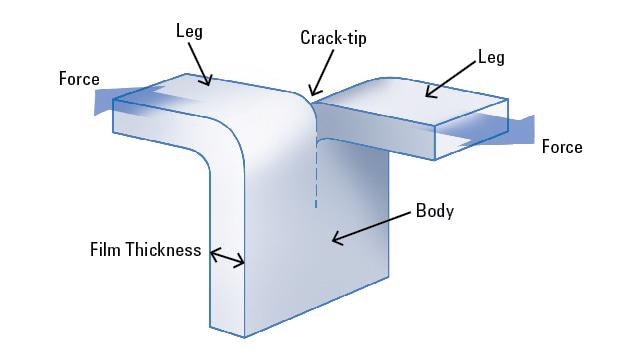The interest in thin polymer films is increasing in the biological sciences and semiconductor packaging, as well as their popular application as packaging materials. Researchers are also showing interest in studying mechanical stresses and fracture behavior in soft biological materials [1, 2]. In many such applications, thin polymer films experience severe mechanical stresses during both handling and actual usage. While most of these films are durable under tensile stresses, they are very prone to failure upon tearing. Thus, it is quite important to know the critical energy release rate during fracture of the films for accurate material design.
One technique commonly utilized to measure the critical fracture energy during fracture of rubber-like materials is a trouser-tear test [3]. This method got its name because the specimen for these tests consists of a rectangular sheet cut along its long axis to form a trouser-shaped sample (see Figure 1). The ‘legs’ of the trouser specimen are then pulled in opposite directions to create tearing action. Determination of critical fracture energy from other test methods requires accurate determination of crack length, whereas the critical energy release and rate of crack propagation during a trouser-tear test are independent of crack length and sample geometry.

Figure 1. Schematic of trouser-tear test specimen.
This brief article details a recent study to determine the critical fracture energies during tearing fracture of two different types of packaging tapes. A state-of-the-art universal testing machine (UTM) from KLA was utilized for the work presented. The KLA T150 UTM employs a nanomechanical actuating transducer head to produce load on sample using electromagnetic actuation combined with a precise capacitive gauge, delivering outstanding sensitivity over a large range of strain.
Theory
The critical fracture energy from a tear test is also known as tearing energy, which is the energy spent per unit thickness per unit increase in crack length. Tearing energy includes surface energy, energy dissipated in plastic flow processes, and energy dissipated irreversibly in viscoelastic processes. The advantage of using the trouser-tear test lies in the assumption that all of these changes in energy are proportional to crack length and is primarily affected by the deformation in the vicinity of the crack-tip. Hence, the total energy is independent of the shape of the test specimen and the way the forces are applied. In other words, although the stress distribution at the tip of a tear crack is complex, it is independent of the crack length [4].
In mathematical terms, the work done during a tear test can be given by:

where F is the tearing force and Δc is the tear distance [3]. It is important to note that the changes in extension of the material between the tip of the tear and the legs are negligible and were ignored in this equation.
The tearing energy, or critical fracture energy, can be written as:

where B is the thickness of the specimen. Hence, by combining Equations 1 and 2:

It can be confirmed from Equation 3 that the critical tearing energy is independent of the initial sample geometry and crack length. The critical tearing energy could have also been calculated using Equation 2, although more complicated crack length measurement before and after the tear test is needed to achieve good results.
Experiment
Two different polymer tapes were used for this study: Scotch Magic Tape 810 from 3M (i.e., Sample A) and Permanent Double Stick Tape from Henkel Corporation (i.e., Sample B). From the material safety data sheet (MSDS) of Sample A, the film material is known to be cellulose acetate [5]. Such information is not available for Sample B; however, most double-sided tapes are made of polypropylene.
The thickness of Sample Ais 59μm, whereas the thickness of Sample Bis 72μm. One sharp crack along the long dimension of each specimen was introduced using a sharp razor blade. Then the two ‘legs’ were glued to two small cardboard pieces and mounted in the T150 UTM using the standard template grips, as shown in Figure 2.

Figure 2. Mounting of tear test specimen in the KLA T150 UTM using standard template grips.
The tearing tests were performed under quasi-static loading at an extension rate of 100μm/s. The load on specimen and specimen extension values were recorded during loading, tearing, and unloading of the specimen. Three different specimens of each type of polymer tape were studied to get an idea of the statistical variation.
Results
The load-extension curves for Samples A and B are shown in Figures 3(a) and 3(b), respectively. It is clearly evident from these results that it takes much lower force to tear Sample A compared to Sample B.


Figure 3. Load-extension response during the trouser-tear test for (a) Sample A and (b) Sample B.
The nonlinear segments of the curves, prior to tearing and during unloading, correspond to stored strain energy in the legs of the specimen. The average force during the tearing process for Sample A is 49mN and for Sample B is 100mN. It is important to note that the small fluctuations in the force values during tearing are not noise from the instrument but rather due to the stick-slip behavior observed during fracture in many polymers. The maxima occur when the crack extends and the minima represent crack arrest [6]. The interval of these fluctuations most probably relates to the morphology of the material, such as the distribution of crystalline and amorphous phases. However, systematic microstructural characterization is needed to fully understand the stick-slip behavior.
The calculated tearing energies (Equation 3) for both samples are listed in Table 1, along with the tearing force and film thickness. Sample B exhibits higher tearing energy compared to Sample A. One would use Sample B in applications where higher resistance to tear is needed.
Table 1. Results of trouser-tear tests on polymer films.
| Sample A |
59 |
52 ± 2 |
1750 ±; 80 |
| Sample B |
72 |
97 ± 1 |
2700 ±; 22 |
Tearing energy is of particular interest for designing materials and microstructures of thin polymer films for different applications. Note that the exact nature of the material morphology and its effect on the tearing energy were outside the scope of this study. Future work can potentially shed more light on the fracture process of different polymer films.
Conclusions
The critical tearing energy for two commercially available polymer tapes was measured via trouser-tear tests using a KLA T150 UTM. The instrument’s ability to measure small loads, along with its high force resolution, enabled the capture of variations in force during tearing of thin polymer films, which should inspire new studies to determine the effect of morphology and crystallinity on the exact nature of crack propagation in these films. Similar tear tests can also be performed on other biological samples, such as microalgae, where it is difficult to control the sample dimensions.
References
1. Mach, K.J., D.V. Nelson, and M.W. Denny, "Techniques for predicting the lifetimes of wave-swept macroalgae: a primer on fracture mechanics and crack growth," Journal of Experimental Biology, 2007. 210: p. 2213-2230.
2. Mach, K.J., et al., "Death by small forces: a fracture and fatigue analysis of wave-swept macroalgae," Journal of Experimental Biology, 2007. 210: p. 2231-2243.
3. Ward, I.M. and J. Sweeney, The Mechanical Properties of Solid Polymers 2008: John Wiley and Sons, Ltd.
4. Greensmith, H.W. and A.G. Thomas, "Rupture of rubber. III. Determination of tear properties," Journal of Polymer Science, 1955.18(88): p. 189-200.
5. http://www.ivinc.com
6. Anderson, T.L., Fracture Mechanics: Fundamentals and Applications: CRC Press.

This information has been sourced, reviewed and adapted from materials provided by KLA Corporation.
For more information on this source, please visit KLA Corporation.